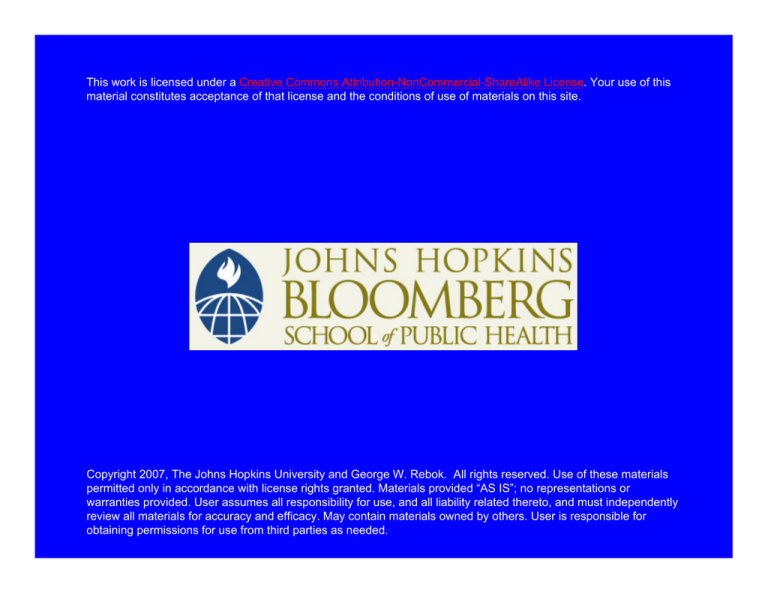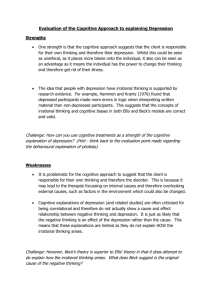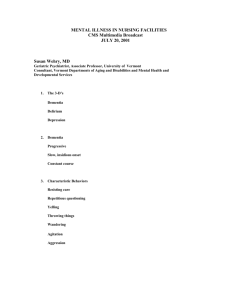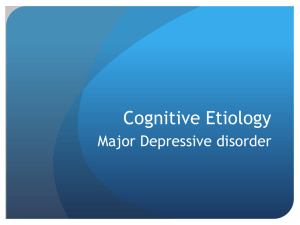
This work is licensed under a Creative Commons Attribution-NonCommercial-ShareAlike License. Your use of this
material constitutes acceptance of that license and the conditions of use of materials on this site.
Copyright 2007, The Johns Hopkins University and George W. Rebok. All rights reserved. Use of these materials
permitted only in accordance with license rights granted. Materials provided “AS IS”; no representations or
warranties provided. User assumes all responsibility for use, and all liability related thereto, and must independently
review all materials for accuracy and efficacy. May contain materials owned by others. User is responsible for
obtaining permissions for use from third parties as needed.
Mental Disorders in Older Adults
George W. Rebok, Ph.D.
Department of Mental Health
Bloomberg School of Public Health
A Key Question
How is it that one individual may seem to be
able to integrate painful conditions of old
age into a new form of psychosocial
strength, while another may respond to
similar conditions in a fashion that seems to
inhibit effective integration and healthy,
ongoing development? (Erikson, 1986)
Components of Successful Aging
• Low risk of disease and disease-related
disability
• High mental and physical functioning
• Active engagement with life
Best Estimate 1-year Prevalence Rates Based
on ECA, Age 55+
Any anxiety disorder
Simple Phobia
Social Phobia
Agoraphobia
Panic Disorder
Obsessive-Compulsive Disorder
Any Mood Disorder
Major Depressive Episode
Unipolar Major Depression
Dysthymia
Bipolar I
Bipolar II
Schizophrenia
Somatization
Antisocial Personality Disorder
Anorexia Nervosa
Severe Cognitive Impairment
Any Disorder
Prevalence (%)
11.4
7.3
1.0
4.1
0.5
1.5
4.4
3.8
3.7
1.6
0.2
0.1
0.6
0.3
0.0
0.0
6.6
19.8
Developmental Considerations
Important to distinguish among:
(a) Those who had the disorder earlier in life and are
experiencing a continuation or recurrence
(b) Those with a vulnerability from earlier in life
that is exacerbated in old age and only then results
in mental disorder
(c) Those who experience a new disorder in later
life
(d) Older adults who had a disorder earlier in life
but do not show any evidence of disturbance in
old age
The Big Three: Depression,
Delirium, and Dementia
• Most diagnostically challenging of mental
disorders experienced by adults
• Failure to accurately assess these disorders can
lead to substantial long-term consequences for
older adults
• Symptoms of depression, delirium, and some
dementias can be decreased or eliminated with
proper diagnosis and treatment
When cognitive function goes bad:
Dementia
• A syndrome
• A global deterioration of cognitive function in
clear consciousness
• Multiple etiologies: most common form is
Alzheimer’s disease (AD)
• Typically progressive or irreversible
• About 10-20% of cases are treatable or reversible
(e.g., depression, drug intoxication, thyroid
disease and vitamin deficiencies,
neurosyphilis,chronic infections, tumors)
Depression As a Risk Factor for
Dementia
• Depression associated with significant
cognitive deficits
• Depression may co-occur with dementia
• In population samples, demented persons
appear to have a higher prevalence of
depression
• Several plausible hypotheses about nature
of the depression-dementia relationship
Delirium
• Frequently overlooked or misdiagnosed
• Characterized by a disturbance of
consciousness and a change in cognition
over a short period of time (usually hours or
days)
• Several different etiological mechanisms
• Diagnosed independently of dementia
DSM-IV Criteria for Diagnosis of
Alzheimer’s dementia
• Gradual onset and continuing decline from a previously
higher level, resulting in impairment of social and
occupational function (i.e., IADLs)
• Impairments in memory and 1 other cognitive domain:
- Language
-Word-finding difficulties
- Disturbance of praxis
- Disturbances of visual processing
- Visual agnosia
- Constructional disturbances
- Disturbances in executive functioning, including abstract reasoning and
concentration
• Cognitive deficits are not due to psychiatric disease,
neurological diseases, or systemic disease
• Cognitive deficits do not occur exclusively in the setting of
delirium
Epidemiologic Implications of
Progressive Dementias
• People > 65 years projected to represent
20% of US population by 2030
• Paradox of increasing longevity – dementia
a byproduct of successful aging
• Incidence of dementia rises steeply with
age, doubling every 5 years after age 65
• Long duration: 10 years from diagnosis
SCORE
ALZHEIMER DETERIORATION ON
THE MINI-MENTAL STATE EXAM
OVER TIME
30
25
20
15
10
5
0
-5
0
5
10
AVERAGE TIME OF ILLNESS (years)
Prevalence and Incidence of AD
increase exponentially with age
• Anchor point: Annual incidence is ~1%
between ages 75-79
• Incidence doubles every 5 years
- 0.25% between 65-69, 0.5% between 60-75
- 2% between 80-84, 4% between 85-89
- 6-8% (!) between 90-94
- May stabilize or decline thereafter
Looming growth in the
Prevalence of AD
• World populations are aging rapidly
• Prevalence is a function of both incidence
and duration
• Duration of prevalent cases is being
extended
• Unintended consequences of new drugs that
stabilize and prolong life after onset of AD
Percent/Prevalence increases with age:
Canadian data
60
50
40
30
20
10
0
65
70
75
80
85
90
95+
Looming growth in prevalent
cases of AD (USA – millions)
•
•
•
•
Present
2010
2030
2050
1.6 - - 2.3 - - 4.3
1.7 - - 2.9 - - 5.7
2.1 - - 4.8 - - 9.8
4.0 - - 8.7 - - 15+
Brookmeyer R, et al. Am J Pub Health 1998;88:1337
Potential Effects of Intervention to Delay
Onset - - Prevalent Cases (USA)
Risk Ratio
1.00
Mean delay
0
2007
2.89
2027
4.74
2047
8.64
0.90
1.0
2.68
4.31
8.26
0.75
2.0
2.32
3.64
6.70
0.50
5.0
1.74
2.49
4.60
Brookmeyer, R. et al. Am J Publ Hlth, 1998, 88:1337
•
Economic Impact of Delaying
AD Onset
• Total costs associated with AD estimated about $47,000/yr
in 1990 dollars (includes direct costs of nursing care and
paid home care as well as unpaid home care) .
• An average 1-year delay in disease onset would result in
annual savings of about $10 billion at 10 years after
initiation of intervention.
• Even a 6-month delay would correspond to an annual
savings of about 4.7 billion at 10 years, and nearly $18
billion annually after 50 years.
• Estimates may be biased
Cognitive Reserve Hypothesis
• Cognitive reserve refers to the total
cognitive resources available to the
individual
• Having greater cognitive resources may
help buffer against decline
• Protects against damage of early stages of
decline
• Delays onset of symptoms of decline
Cognitive Reserve
Latent
NSAIDs
Estrogens
Antioxidants
Statins
Pro-drome
Dementia
Age
AD has an insidious onset and a slow, progressive course that leads to a decline in cognitive capacities. Recent
studies suggest that the neuropathogenesis of AD may begin as early as midlife and can be characterized as
passing through 3 phases as shown by the solid curve. During the latent phase, neuro-degenerative events
proceed without apparent symptoms. As damage to the brain accumulates, the latent phase gives way to a
prodromal phase, and mild cognitive impairments begin to emerge. Eventually, cognitive reserves are depleted,
and the worsening symptoms cross a threshold that fulfill the criteria for the diagnosis of dementia. A growing
body of evidence suggests that several commonly used medications may disrupt the pathologic events of AD
and thereby delay or even prevent the onset of clinical dementia. This is shown by the dashed curve. The most
promising of the these candidates are non-steroidal anti-inflammatory agents (or NSAIDs), estrogen
replacement therapies, antioxidant vitamins and statins.
Factors Influencing Alzheimer’s Disease
(age at onset, rate of progression)
•
•
•
•
•
•
•
•
Age*
Genetic influences*
Genotype (presenilin, APOE)*
Female gender
Lack of education
Environment (head injury)
Medications: NSAIDS, statins, female HRT
Vascular disease
APOE and AD (cont.)
• Those with ε4/ε4 tend to get AD between
65 – 80 and have 15-fold risk, (vs. ε3/ε3)
after adjustment for age.
• Those with ε4/ε3 get AD between 75 and 90
and have 3-4 fold risk.
• The ε2 allele may confer decreased risk.
Candidate “protective” factors
associated with delayed onset
• Estrogen/Hormone Replacement Therapy
• Non-Steroidal Anti-Inflammatory Drugs:
- over 20 observational studies, almost all
showing inverse association with AD.
• Histamine H2 blocking drugs
• Antioxidant vitamins & Red Wine
• “Statin” drugs
Moving Toward Prevention of AD: Rise
of Mild Cognitive Impairment
• Often a preclinical stage of progressive dementias, such as
AD and now, Vascular Dementia
• How to identify subclinical cognitive impairment?
• Varying definitions and prevalences
- Age-associated Memory Impairment (Crook, 1986).
More than simply memory loss
- MCI (Petersen, 1989). Emphasis on memory
- Differential reliance on presence of objective as well as
subjective memory problems
- Differential reliance on presence of IADL difficulties, by
self-report
Conclusions
1. AD a prevalent disorder with growing
public health implications.
2. A large majority, but not all, of the
population will develop AD by age 100+
3. Incidence and prevalence increase
exponentially through 90+ but decline
thereafter.
Conclusions (cont.)
4. Potential interventions at 3 stages –
primary, secondary, and tertiary prevention
5. Primary prevention may be possible with
HRT (seems doubtful), NSAIDS, H2
blockers, Anti-oxidants, Statins
6. Trials needed. No agent has yet to halt or
reverse symptoms of AD in randomized
trials.
Conclusions (cont.)
7. Need for preclinical detection for
prevention or delay of symptom onset.
8. Presently, focus is on earlier detection of
memory and cognitive declines (i.e., MCI)
Main Areas of Prevention in Old Age
• Prevention of skill loss and promotion of competency
• Prevention of psychological and physical conditions
associated with dementia
• Prevention of major depression
• Prevention of suicide and relapse
• Stress and anxiety prevention
• Prevention of loss of control and self-esteem enhancement
• Prevention of institutionalization
• Preventive health
- Diet
- Nutrition
- Exercise
“Use it or Lose it” Hypothesis
• Has great popular appeal but has seldom been
empirically tested
• Effortful cognitive activities appear to be
protective against dementia in some studies
• Results of cognitive training studies show
evidence for considerable cognitive plasticity
• Controlled trials are needed to assess effects of
cognitive leisure activities on risk of dementia
ACTIVE
Advanced Cognitive Training Intervention
for Vital and Independent Elders
ACTIVE Steering Committee
Funded by the National Institute on Aging
and the National Institute of Nursing Research
ACTIVE: Primary Aim
To test the efficacy of three cognitive
interventions, to improve or maintain the
cognitively demanding activities of daily living.
Study Design
Older
Older Adults
Adults in
in Study
Study Area
Area
Ineligible
Ineligible
Refused
Refused
Screen
Screen for
for Eligibility
Eligibility
Eligible
Eligible and
and Consenting
Consenting
Baseline
Baseline Measurements
Measurements
Randomize
Randomize to
to Training
Training
Memory
Memory
Reasoning
Reasoning
Speed
Speed
No
No Contact
Contact
Post-Test
Post-Test
Post-Test
Post-Test
Post-Test
Post-Test
Post-Test
Post-Test
Booster
Booster
Booster
Booster
Booster
Booster
Yes
Yes
No
No
Yes
Yes
No
No
Yes
Yes
No
No
1-Yr
1-Yr Test
Test
1-Yr
1-Yr Test
Test
1-Yr
1-Yr Test
Test
1-Yr
1-Yr Test
Test
2-Yr
2-Yr Test
Test
2-Yr
2-Yr Test
Test
2-Yr
2-Yr Test
Test
2-Yr
2-Yr Test
Test
Baseline Characteristics (n=2,802)
•
•
•
•
•
•
Mean Age: years
Gender: Female
Race: African American
Education: H.S. diploma
Marital Status: Married
Cognitive Status: MMSE score
73.6 (5.9)
75.9%
26.0%
88.6%
35.9%
27.3 (2.0)
Range 65-94
Simplified Conceptual Model
Participant
Characteristics
⇒
Training
⇒
Cognitive
Abilities
Proximal
Outcomes
⇒
Daily
Function
Primary
Outcomes
Memory Proximal Composite
1.5
Blom Z
1
Memory
Reasoning
0.5
Speed
Control
0
-0.5
Baseline
Posttest
First Annual
Occasion
Second
Annual
Reasoning Proximal Composite
2.5
Blom Z
2
Memory
1.5
Reasoning
1
Speed
0.5
Control
0
-0.5
Baseline
Posttest
First Annual
Occasion
Second
Annual
Speed Proximal Composite
1
Blom Z
0
Memory
-1
Reasoning
-2
Speed
-3
Control
-4
-5
Baseline
Posttest
First Annual
Occasion
Second
Annual
Training Effects on Proximal
Outcomes
•
•
•
•
Immediate effect
Durable to 2 years
Specificity of training effects confirmed
Effect sizes as expected
Effect of Training on Cognitive Abilities -5 yrs
0.6
Standardized Training Effect Size
(Control Group as Reference)
0.5
0.4
0.3
Memory composite
Reasoning composite
Speed composite
0.2
0.1
0
Memory trained
Reasoning trained
-0.1
Training Group
Speed trained
Training Effects on Daily Function - 5yrs
• All trained participants reported less
difficulty with IADLs compared to control
group; Significant only for Reasoning
training.
• Training had no effect on performance-based
measures of function. However, booster
speed training improved performance in
Everyday Speed.
• Training effects were modest, however have
not been reported previously.
Effect of Training on Function: Self-Reported IADLs
– 5 yrs
0.2
Mean IADL Difficulty Score
0.1
0
-0.1
-0.2
-0.3
-0.4
-0.5
-0.6
-0.7
-0.8
Baseline
(N=2802)
Year 1
(N=2325)
Memory trained
Year 2
(N=2234)
Time
Reasoning trained
Year 3
(N=2101)
Speed trained
Year 4
Control
Year 5
(N=1877)
An Intergenerational Approach
to Cognitive and Behavioral
Enhancement: The Experience
Corps Program
What is the Experience Corps?
• A new model of senior service and health
promotion
• Designed to simultaneously create new,
generative roles for older adult meeting
unmet needs of public elementary schools
• Designed in 1994-95 by Dr. Linda Fried
and Mr. Marc Freedman
Causal model of intervention
pathways for older adults
Intervention
Primary
pathways
Physical
activity
Experience
Corps
Participation
Social
activity
Cognitive
activity
Mechanisms
+ strength / balance
- falls
- insulin resistance
- blood pressure
Outcomes
Physical
function
(mobility)
+ social support
Global
function
- depressive sx
(IADL’
IADL’s)
Optimal health care
utilization
+ efficacy (individual
& collective)
Cognitive
function
(memory &
executive function)
What We’ve Learned So Far
•
•
•
•
Can recruit a large group of elderly volunteers
Retention rates are high
Volunteers accept the need for randomization
Program perceived as widely attractive to
older adults, well-accepted by participants,
including principals, teachers, and children
• Results show initial positive benefit in
selected areas of function:
– physical: improved chair stand & telephone time
– cognitive: improved verbal delayed memory
Depression
• Most common mental disorder
• Term used synonymous with Common
Mental Disorder, i.e., includes the broad
spectrum of depression and anxiety
disorders
• Single most important cause of disability
among mental disorders
(Global Burden of Disease Report, 1996)
Diagnosable Syndromes of
Depression
• Include affective, behavioral, somatic, and
cognitive symptoms
• Affective symptoms: depressed mood or sadness,
feelings of loss of pleasure, irritability, anger
• Behavioral symptoms: decreased activity, changes
in movement, agitation
• Somatic signs: significant weight changes, sleep
changes, loss of energy, fatigue, lethargy
• Cognitive symptoms: feelings of worthlessness,
futility, helplessness, hopelessness, loss of
motivation, suicidal thoughts, poor memory,
difficulty concentrating, difficulty making
decisions
DSM-IV Diagnostic Criteria
• Depressed mood and/or loss of interest in
pleasurable activities nearly all day or every day
for at least 2 weeks
• Must experience 3 or more of following symptoms
for a total of at least 5 symptoms:
significant weight change, sleep disturbance,
psychomotor retardation or agitation, low energy,
poor concentration, recurrent thoughts of death or
suicide
• Symptoms cause clinically significant distress
Dysthymic Disorder
• Less severe form of depression
• Individual experiences depressed mood and at
least 2 additional symptoms (appetite disturbance,
sleep dysregulation, fatigue, low self-esteem, poor
concentration, sense of hopelessness) for a period
of at least 2 years
• Individuals with dysthymic disorder may develop
major depressive disorder
• “double depression” involving recurrent episodes
of major depression separated by episodes of
dysthymia
Life-Span Questions for Further
Study
• Is there a commonality among depressions that
begin at different ages?
• If not, are the differences due to developmental
forces shaping the same underlying disorder, or
are they really different forms of depression?
• Should “recurrence” be a critically defining
feature of depression?
• Do the same processes underlie first onset,
maintenance, and recurrence of depression across
the life span?
Depression in Older Adults
• Older persons with depression may not present
with typical symptoms of depression such as
sadness.
• Older patients with depression often have
unexplained somatic complaints and exhibit a
sense of hopelessness
• Anxiety and anhedonia are also encountered
frequently
• Other features that may indicate underlying
depression include memory complaints, slowness
of movement, and lack of interest in personal care
• May be difficult to detect because of frequency of
comorbid psychological and medical conditions
Depressive Symptoms and
Functional Impairment
• Depressive symptoms associated with the
development of functional impairment in
the elderly
• Processes underlying the depressionfunction relationship are poorly understood
• Important to study mediators of the
relationship between depression and
functional impairment
Disability and depression
Depression
Depression
Depression
Cognition
Cognition
Cognition
Function
Function
Function
Time
ACTIVE study
Disability and depression
Depression
Depression
Depression
Cognition
Cognition
Cognition
Function
Function
Function
Time
ACTIVE study
Treatment Approaches to Mood
Disorders in Later Life
• Pharmacotherapy has proven effective for treating
depression in older adults at all levels of severity
(50-70% effectiveness rates)
• Effectiveness of psychodynamic and self
psychological approaches limited to anecdotal
case reports and a few empirical reports of life
review
• Empirical studies support efficacy of cognitive
and behavioral treatments (Thompson et al., 1987)
• Some support for effectiveness of family therapy
but more outcome studies are needed
• Integrating multiple treatment modalities has
proven effective in treating mood disorders








